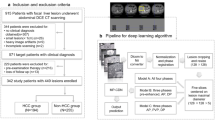Abstract
Tumors are generally difficult to detect in Magnetic Resonance (MR) images as they can be of varying intensities and do not appear as clear structures on these images. This difficulty is more prominent in MR Cholangiopancreatography (MRCP), which is the MR technology using a special sequence of T2-weighted imaging to identify the biliary tract, pancreatic duct, and gallbladder in the liver region, as MRCP images are more noisy in nature and are acquired for a more focused area with too much flexibility in position orientation for convenient computer-aided diagnosis. Based on the principle that the tumor mass manifests itself as blockage of the biliary tree structure, this paper introduces a technique that uses a region growing algorithm to identify discontinuities in the biliary tree as a means to preliminary detection of a possible tumor, in a fashion similar to the visual observation used by most radiologists in making their preliminary diagnosis. Through the use of appropriate image normalization, watershed segmentation, thresholding, rule-based region growing, and region analysis, the proposed technique is shown in this paper to be successful in identifying MRCP images with liver carcinoma from those with normal liver. Acquisition standardization, interactive image selection, and optimum image orientation will further enhance the accuracy of this proposed scheme for use in aiding clinical diagnosis at medical institutions.









Similar content being viewed by others
References
Justus, G. S., and Korah, I., Non-breath-hold magnetic resonance cholangiography—preliminary results and review of literature. Indian J. Radiol. Imaging 9(2):53–58, 1999.
Lee, M.-G., Jeong, Y. K., Kim, M. H., Lee, S. G., Kang, E. M., Chien, D., Shin, Y. M., Ha, H. K., Kim, P. N., and Auh, Y. H., MR cholangiopancreatography of pancreaticobiliary diseases: Comparing single-shot RARE and multislice HASTE sequences. AJR 171:1539–1545, 1998.
Schapiro, R. H., ERCP in the diagnosis on pancreatic and biliary disease. In ERCP: Diagnostic and therapeutic applications, Elsevier, NewYork, pp. 9–39, 1989.
Sugiyama, M., Atomi, Y., and Hachiya, J., Magnetic resonance cholangiography using half-fourier acquisition for diagnosing choledocholithiasis. AJG 93(10):1886–1890, 1998.
Lo, P., and Bister, M., Multiresolution graphical user interface for efficient labelling of tomographic images. Kuala Lumpur Int. Conf. Biomed. Eng. IFMBE Proc. 7:213–216, 2004.
Bartels, Beatty, and Barsky: An Introduction to Splines for Use in Computer Graphics and Geometric Modeling, Morgan Kaufmann, San Mateo, CA (1987)
Lo, P., Bister, M., and Eswaran, C., Watershed segmentation with gradient threshold and root merging for ultrasound images. Proceedings of the South-East Asian Congress of Medical Physics and Asian-Oceania Congress of Medical Physics, pp. 251–256, 2004.
Romeny, B., Front-end vision and multi-scale image analysis, Kluwer, Dordrecht, The Netherlands, 2002.
Logeswaran, R., Scale-space segment growing for hierarchical detection of biliary tree structure. Int. J. Wavelets Multiresolution Inf. Process. 3(1):125–140, 2005.
Gonzalez, R. C., and Woods, R. E., Digital Image Processing, 2nd edn., Prentice-Hall, Englewood Cliffs, NJ, 2002.
Yan, F., Zhang, H., and Kube, C. R., A multistage adaptive thresholding method. Pattern Recognit. Lett. 26(8):1183–1191, 2005.
Acknowledgements
This project was supported by the Ministry of Science, Technology and Innovation, Malaysia, through the IRPA Grant scheme. The authors would like to express their appreciation to the collaborating radiologist, Dr. Zaharah Musa of Selayang Hospital, Malaysia for the test images and medical consultation for this study.
Author information
Authors and Affiliations
Corresponding author
Rights and permissions
About this article
Cite this article
Logeswaran, R., Eswaran, C. Discontinuous Region Growing Scheme for Preliminary Detection of Tumor in MRCP Images. J Med Syst 30, 317–324 (2006). https://doi.org/10.1007/s10916-006-9020-5
Received:
Accepted:
Published:
Issue Date:
DOI: https://doi.org/10.1007/s10916-006-9020-5




